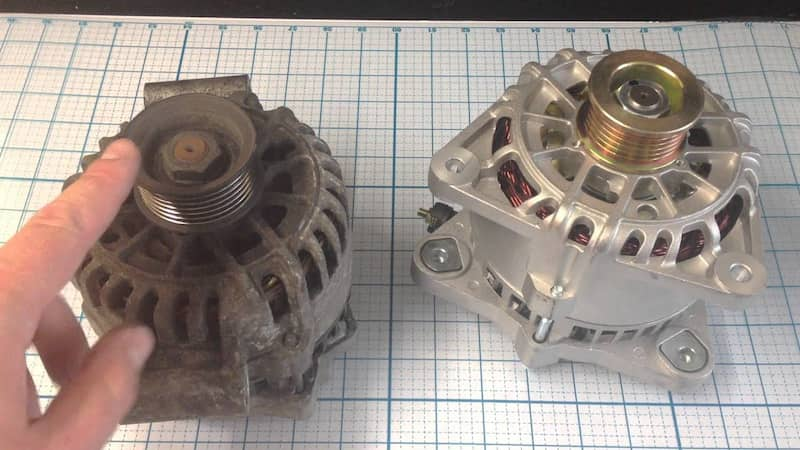The L405 Range Rover has a wonderful performance. However, drivers don’t always have good experiences with it. So what are L405 Range Rover common problems?
Like any vehicle, L405 Range Rover is not immune to malfunctions. You should learn all the possible cases to deal with them confidently.
Don’t know where to start? This article can be an ideal place to take your first step. We will cover the most common Range Rover issues, their causes, and how to fix them. Let’s dig into the details!

L405 Range Rover Common Problems
The L405 Range Rover experiences issues mostly in its transmission and suspension systems. However, you should also pay attention to other parts and perform the proper steps to fix them.
Sluggish Transmission
Sluggish transmission is common in L405 Range Rover, especially in old models. It usually results from the low transmission fluid, making the whole transmission system unresponsive.
Moreover, the transmission fluid may wear out over time. Then, it can’t lubricate the system as it used to. The transmission components will slip and break down soon.
Another issue with the transmission is a blockage. Since it has to work with contaminants and debris, they may build up and restrict the fluid flow.
The transmission of the L405 Range Rover requires regular maintenance. If you notice any rough shifting, take your vehicle to the nearest garage for help.

Bad Alternator
The alternator of your L405 may malfunction, shutting down the system for nearly one hour. The battery will drain completely after that. There will also be a warning of the charging system error and a battery check light.
Alternators can last for about 100,000 miles. You will experience the above issues if your vehicle has reached this mark. In this case, you have to replace the alternator.
Rattling Noises
The 2013-14 Land Rover L405 had problems with their V8 engines producing rattling noises. You may notice it when driving over irregular road surfaces like bricks and cobblestones.
To fix this issue, you have to replace the engine mounts. And if the rattling noises remain, your vehicle may require a new steering gear.

Clunking Noises
The clunking noises arise for multiple reasons, with the Range Rover L405 transfer case problems being the most regular.
For example, if the transfer case fluid is too old, you will notice that noise when turning or accelerating. Hence, remember to replace it every 80,000 miles.
If replacing the transfer case fluid can’t solve the problem, check for other causes, like the bushings or front control arm. They need replacements after 30,000 to 40,000 miles.
Tailgate Problems
You can use the automated sensor on the tailgate to open the trunk. This feature makes your L405 convenient.
However, some drivers complain about Range Rover L405 tailgate problems. When they press “unlock” or use a key fob to turn on the tailgate, the rear tailgate is sometimes unresponsive.
If you have the same issue, detach the rear cover to check the system, which includes the moving components and electrical attachments.
If the moving parts seem to work correctly, but you can’t open the rear hatch, try increasing the voltage to power the gear motor. This step assumes that the root of the problem is the gear motor. If it has worn out, you must let your engine idle and press the rubber button at the back.
Radiator Leaks
The radiator corrodes over time, developing some small holes. Besides, radiator leaks may result from physical damage or worn-out seals. You will also have the same problem due to improper installation.
The radiator leak issues cause the level sensor in the expansion tank to detect low coolant levels. Then, it will trigger a warning signal. You can only eliminate it by replacing the main cooling radiator.

Brake Pads And Discs
The L405 brake calipers have an electronic control unit. The specialist diagnostic equipment must be up to date in order to retract the pistons to replace the pads.
The brake pads and discs of the L405 Range Rover wear out quickly, requiring replacement after every 30,000 miles. The lifespan of those components depends on your driving habit and poor-quality products.
Besides, the brake discs may become warped because of the frequent heavy braking. They will cause the brake pedal to vibrate.
Some L405 Range Rover drivers also report a squeaking sound while driving. In this case, you need to check all the components in the brake system.
Worn-out parts will decrease the overall performance of the system. Hence, you have to maintain them regularly and properly because faulty brakes can result in severe accidents.
Faulty Suspension System
L405 Range Rover is a high-performance vehicle. However, it still has trouble with the air suspension system. For example, leaks in the air lines or other components reduce the air pressure. There will be a loss of ride height as a result.
Besides, you should be more attentive to the air struts. They are made of rubber and can rot, crack, and puncture.
So, if you notice Range Rover L405 suspension problems, inspecting the air suspension system is a must. Some components, especially the struts, require regular replacements.
AC Problems
Electrical faults will prevent your AC system from working normally. The dirty pollen filter can also deteriorate the performance of the ventilation system. Then, you will notice decreased cooling and air movement.
Feeling hot is not the only issue. The malfunctioning ventilation system poses unnecessary stress on the AC system, too. It will finally decrease your L405’s fuel economy.
To troubleshoot your AC issues, check the air filter first. You can use a vacuum cleaner to remove dirt particles accumulated there. And if the issue remains, consider replacing the filter.
Gearbox
The L405 Range Rover is famous for its automatic gearbox issues after every 80,000 miles. The faults can be shuddering at high speeds or slow gear shifting. The lock-up torque converter is also a common mishap.
When failed, the gearbox calls for an expensive repair, about thousands of dollars. As a result, some L405 owners choose to sell their cars instead.
Crankshaft Failure
The 2012 Range Rover could encounter crankshaft failure for these two reasons:
- Wrong location of the main crankshaft bearing shells during construction
- Rotation of the crankshaft bearing shells during ordinary usage
Owners have complained about abrupt engine failure. They had less than 30 seconds to pull off the road and noticed irregular engine noises. Hence, a new crankshaft bearing design is needed to prevent failure.
Easy To Steal
Range Rovers, in general, are one of the most stolen cars because they are easy to steal. Criminals can intercept the signal given off from your keyless key, even if the key is inside your house.
Range Rover L405 Recalls
The model was recalled 13 times between 2012-2018. The reasons for this varied, including fire hazards, front passenger airbags not deploying, and front passenger seat belt issues.
There was also a recall in 2015 when the doors didn’t catch on the primary or secondary latch. This issue could result in doors opening and increase the risk of a vehicle crash or jeopardize the passengers.
Conclusion
L405 Range Rover common problems include transmission, suspension, radiator, and alternator issues. There are also other errors that you may encounter in every vehicle model.
If you suspect a faulty component in your vehicle, check it carefully. A qualified mechanic will help you diagnose it correctly and fix it properly.
Having a car is not just about driving it. As an L405 Range Rover driver, you should be aware of how to bring out the best of it. Hopefully, this article can help you with that.
Thank you for reading!

Hi! My name is Mark Stevens – the founder of Auto News Portal.
I wrote articles in the automotive industry for more than 10 years, published in USA, Europe and the Asia. I love sharing my knowledge and insights with fellow enthusiasts. Join me on this journey as we explore the exciting world of cars together!



